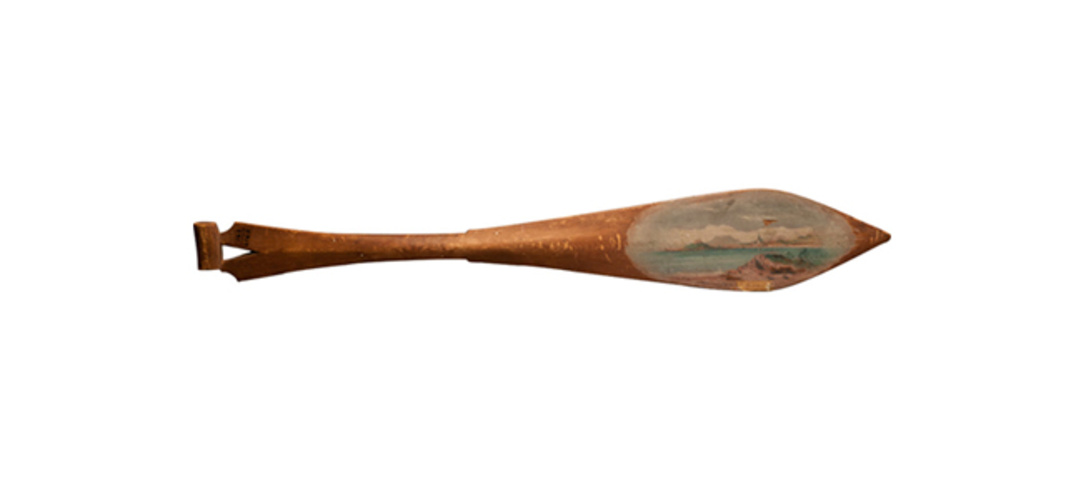Unknown Maker, Sitka Tlingit
Wood, pigment
23 15/16 x 3 9/16 x 9 1/16 in. (60.8 x 9 x 2.3 cm)
Donated by Dr. Paul A. McAlpin in 1945
American Museum of Natural History 16.1/2169
This miniature wooden paddle featuring a painted landscape of Sitka was collected by dentist Volney McAlpine (1830–1900), probably on one of the two trips he made to Sitka between 1888 and 1890 while seeking gold.1 The quest for gold was something of a McAlpine family tradition, beginning with his father, who traveled to Australia in search of the metal.2 Dr. McAlpine, and later his two sons, like many others of their generation, chose the much closer destination of Alaska in their search.3 What, if any, financial gain the doctor received from his journeys is unknown, but as with many who traveled to the region, he returned with a sizable collection of aboriginal-crafted mementos, including baskets, miniature canoes, and various carvings that he probably purchased from Native street vendors or at curio shops (fig. Va). The collection, which survives in part despite languishing in a family barn for years, was salvaged by the collector’s grandson and donated to the American Museum of Natural History in 1945.4
This paddle was collected along with a second one depicting a salmonberry flower (fig. Vb), a popular regional symbol at the time. The small size of the paddles, combined with the Western-style paintings on their blades, suggests their intended purpose as souvenirs. Model paddles and canoes had proved popular among Euro-North American visitors to the Northwest Coast ever since mariners arrived a century before McAlpine (see model canoe, cat. 29). By the late nineteenth century, both items had become tourist icons of Native peoples, as well as the land and waters they inhabit. “In this coast region,” author Eliza Scidmore wrote in the New York Times in 1884, “where there is no open country and scarcely a natural clearing, with no roads or means of communication save by the labyrinth of channels and passages between the islands, the Thlinkets’ canoe is as much to them as the pony to the ‘Souix’ or the steed to the Arab.”5 Conventionalized images of Natives paddling canoes were common in period tour books promoting the region.6 Canoe-lined shores of coastal towns such as Sitka welcomed visitors as they arrived by steamship, as captured by numerous photographs of the era (see cat. 33).
The carver of this paddle was likely Tlingit, based on the characteristic V notch near its handle, as well as its tapering from thick to thin from the handle to the blade. Although the landscape painting on the paddle’s blade does not follow formline principles, it could have been produced by a Native artist, since some of them worked in Western styles at the time.7 On the other hand, Native-carved souvenir paddles from Alaska are known that seem to have had Western imagery added by their dealers prior to sale.8 Such imagery, in combination with the paddle’s basic outline, is reminiscent of the souvenir spoon craze sweeping the North American continent when these paddles were purchased. Collectible silver spoons, which often featured pictorial artwork on their bowls, covered almost every imaginable subject and were so popular by 1891 that more than seven hundred varieties were reported to be available from jewelers around the country.9 The Northwest Coast was equally engrossed in the spoon-collecting phenomenon, and both Native and non-Native silversmiths were quick to supply the market, producing spoons that featured both formline-style crest motifs (cat. 26) and Western-style landscapes and still-lifes (fig. Vc).10
Although probably made for the tourist trade, the quality of carving of the paddle is consistent with functional, full-size Tlingit paddles; unlike some flat souvenir wall plaques, it is fully carved both front and back. The Tlingit were known to use miniature paddles during hunting expeditions, the small size of the equipment allowing for single-hand use, leaving the other hand available for launching weapons.11 In addition, small paddles may have been produced as training models by young carvers or may have been used as dance props. Although probably not necessary for a tourist piece, the quality of this paddle suggests a pride in craftsmanship on the part of its maker and a potential willingness to repurpose the paddle form for sale as a curio under a foreign artistic system. [Hampton Wayt]
[2] Ken G. Martin, e-mail to author, March 10, 2011.
[3] “Alaska,” New York Times, May 18, 1885.
[4] Letters in the AMNH (accession file 1945-23) from donor Paul McAlpin state that labels on the objects were applied by his grandfather, the collector. A visual inspection of the remaining labels suggests this to be the case, based on their content and handwriting. At some point, the “e” was dropped from the end of the McAlpine name, which became “McAlpin.”
[5] E. R. S., “The Indians of Alaska,” New York Times, November 23, 1884. Although initialed only, the content of “The Indians of Alaska,” combined with information provided in the review of Eliza R. Scidmore, “Alaska: Its Southern Coast and the Sitkan Archjipelago,” New York Times, May 18, 1885, suggests that this article was written by Scidmore.
[6] See, for instance, Francis C. Sessions, From Yellowstone Park to Alaska (New York: Welch, Fracker Co., 1890).
[7] For example, Tsimshian artist Freddie Alexcee (ca. 1853/57–1944) was known to paint in pictorial or narrative styles; see Bill McLennan and Karen Duffek, Transforming Image: Painted Arts of Northwest Coast First Nations (Vancouver: University of British Columbia Press, 2000), 252. See also cat. 32.
[8] Steve Henrikson, personal communication.
[9] “More Souvenir Spoons,” New York Times, July 20, 1891.
[10] June E. Hall, Alaska Souvenir Spoons & the Early Curio Trade (Juneau: Gastineau Channel Historical Society, 2004).
[11] George Emmons and Frederica de Laguna, The Tlingit Indians (Seattle: University of Washington Press, 1991), 85.
















